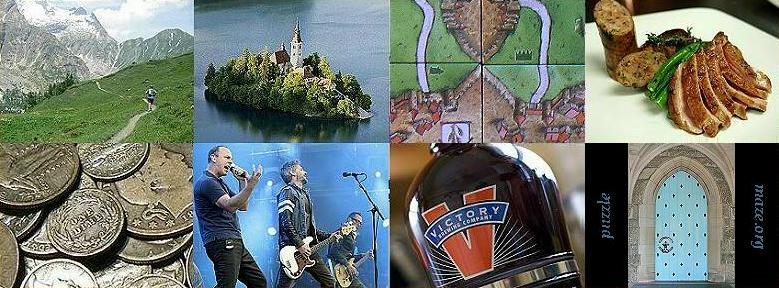
PuzzleMaze - Kazakhstan
 |
The official language is Kazakh (related to Turkic), tho everyone spoke Russian, and the Russian alphabet is used. Ethnic Kazakhs spoke Russian when speaking to each other, and mentioned that Kazakh was generally only spoken in the home. There was talk of replacing the Russian alphabet, and trying to replace the use of the Russian language, but from what I observed, that seems very unlikely to happen. Ethic Russians I spoke to said they were only required to take 2 years of Kazakh language, and were not interested in acquiring further proficiency. The ethnic mix was about 50% Russian, 50% Kazakh, tho I thought it was odd that the police force (and the police are everywhere, with avoidance recommended by the guidebooks) seemed 100% Kazakh. These observations only apply to the city of Ust-Kamenogorsk, which historically was a Russian outpost, so they may be different elsewhere.
For me, getting to the country wasn't too bad, Philadelphia to Frankfurt, then onto Almaty on Lufthansa. I did the 7000 miles (11,000 km) on 50,000 FF miles, otherwise I would not have been able to afford it (I got north of 3 cents/ff mile). I imagine that this is one of the reasons the event was so poorly attended. (By my count, there were 377 people registered, 122 from Russia, 120 from Kazakhstan, 32 from Australia, perhaps a like number from Hong Kong and Japan, the rest from scattered countries around the world. There were 4 from America, and 3 from Canada).
Arranging transport from Almaty to Ust-Kamenogorsk was a different kettle of fish, and foreshadowed the attitude one would have to take when dealing with organizational issues. The options were 24 hour train or bus rides on Soviet era equipment, or booking a "special flight" thru the organizers that did not show up in any airline reservation systems, and paying cash on arrival for it (which would be at midnight). The latter seemed to be a dubious option, given the state of disorganization the organizers seemed to be in based on other pre-event e-mail correspondence, but I opted for it, and much to my surprise and delight, someone who spoke English greeted me at the airport with my onward ticket. The only wrinkle was that they told me the flight left at 21:15 in e-mail, when in fact it left at 9:40 according to the ticket. I was traveling with Sharon Crawford, and we were wondering what we would be doing the next day, when I decided to check the ticket and caught this. This was pretty much the way the whole trip was -- worry if something that you expected to be arranged would be -- no one told you anything until it happened, or told you different schedules, conflicting schedules, etc., but in the end it always worked out, and a little patience and world travel experience went a long way.
The flight was something to behold -- I don't know my Soviet era aircraft, but this turboprop, operated by "Tulpar Avia Service", was definitely 60s or 70s vintage, and looked it. The guidebooks warned that "internal aviation safety standards are not up to those in the west", but it got off the ground and got us there. Security prevented me from photographing the aircraft.
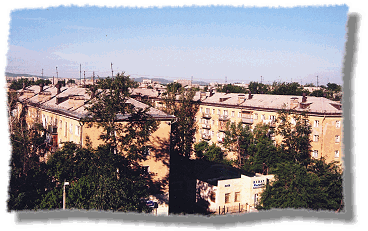 |
The town of Ust-Kamenogorsk -- I would describe as neither modern nor old world. There was a mix of Soviet era buildings and older buildings. There was nothing I would describe as modern. It was a pleasant and bustling town, tho no one mowed any grass, so it looked a bit scruffy and ragged, and no building seemed recently painted. The cars people drove indicated a two class society -- modern Audis and Mercedes jostling with beat up Ladas -- this was confirmed by the people I spoke to, and seems typical of newly capitalist countries. I saw no western restaurants such as McDonalds, etc. Tho Kazakhstan is a Muslim country, I saw little evidence of religion (a couple of Mosques), and the female dress was about as far from modest as could be imagined. The young Kazakhs I spoke to confirmed that they were not religious.
The organizers had arranged for me to lodge in the "three star" Hotel Ust-Kamenogorsk. It was one star, and there is no point in describing its failings. I realise it is all relative, but hotels described as two star in Africa I've stayed in were preferable. The going rate was $15/night, but the organizers were charging me $30. Perhaps I need to go back to my days of being a completely independent traveler.
On the other hand, working with the organizers had its perks. There is no tourism in Ust-Kamenogorsk, and I imagine the tourists that come thru are few and far between, hence no one spoke a single word of English or any of the other Western European languages that I have a traveler's vocabulary in. I'm not afraid to attempt to learn the local language, but admit I was intimidated by my unfamiliarity with the Russian alphabet. The organizers solved this problem by providing us with personal interpreters -- girls who were studying English at school, and wanted to practice on foreigners. Since no English speakers ever come thru, they don't get a chance to practice. It seemed a bit of a paradox, they were studying English from English teachers for prospective careers as English teachers, but there is never anyone to speak English to other than English teachers and students. Fortunately, for them, tho, the Altay seem rife for tourism to develop, and this city is the logical gateway, so there hopefully will be great demand for their services in the future. Additionally, some had ambition to get jobs as international correspondents or in the tourism industry in the more cosmopolitan city of Almaty.
 |
 |
Having these girls was really the hilight of the trip. They spoke surprisingly excellent English, and they were able to practice, while I was able to learn directly some Kazakh culture. And it is always cool to hang out with the locals when you travel. And they went everywhere with us, unless we wanted to go off alone, and they were so nice and friendly. It was really a sweet arrangement, and I hope they got as much out of it as we did. I wish them all the best.
The final note on arrival was trying to arrange transport back to Almaty. I was told to buy a ticket, and it "would be arranged", but "they don't know the flight times yet". Fine. Not what I'm used to, preferring transport to be booked months in advance and not wanting to get stranded here or miss my FF flight, which would cost a fortune, but I made it back.
 |
My view of an ideal model event is a map in your packet, and directions to the terrain. Everything here was so much more formal, tho, with a start and finish chute, and needing to wait to get your map. It was odd that everything was so formal, yet so apparently disorganized.
(Note -- I realise throughout this that my writing may come off as a bit critical of the organizers, and hilight some of the logistical hassles. It is only that way because I wish to write accurately about my experience and what it felt like. The facts are that in a less developed country, there will be logistical snafus and things will seem more of a hassle than one in the West is used to. This just is and has to be accepted. As it turned out, everything did work out in the end, and the organizers had a big heart and went out of their way to make it all work out, and were extremely pleasant and helpful in dealing with issues. It just that they were inexperienced with an event of this size, and the country is difficult to move around in. In sum, this can be preferred to some of the well-run meets I've been to, where everything works like clockwork, but the meet staff is inflexible and surly).
The model was in a flood plain area by a riverbed. It was flat and parts of it looked like a birch plantation area. It looked sort of like what you might see when crossing a large riverbed while driving thru Nebraska. The white woods were pretty, but there wasn't too much of them. There were alot of trails, and alot of rough open. The map printing was not particularly good, and there were some unmapped trails. It was sort of an odd model, as it was a flat, rock free area 2 km from the center of town, whereas the terrain was to be in the craggy foothills 90 km from town. Everyone was doubting its relevance, but I didn't care -- I was happy to be running, and ran it twice, in the 6-6.5 min/k range.
 |
 |
The venue is a section of town near the main square, with a park area, Ust-Kamenogorsk Central Mosque, and apartment buildings and the like. I've never done a "real" sprint before (or actually what I'd call in this case a "street O"), and I'm not sure what to expect. I remember turning the map over and saying "no code" to myself, meaning I was a bit unsure how to handle the very different looking map. No trails, contours, or veg. It didn't look like an O map.
I didn't get in sync on the first leg, and went around the wrong building. I lost some time, but not a ton. After that I was mostly clean (tho I went to one wrong control before I realised they were placing controls 5 meters from each other -- if they had said that in the notes, I would have been ok, as I knew it was not my feature, but I've never seen bags that close), and ran as fast as I could, which isn't very fast. There were these young kids in one of the alleys cheering me on, which was kinda cool, but they did get in my way and cost me 2 seconds.
Since I had never run on this sort of map before, I did not know the symbology, or, more accurately, if there was any special symbology or not. The one thing I learned on the fly was how passages thru buildings are depicted. I just assumed that is what the lighter color meant. That was kinda cool. Otherwise, I guess they are like normal O maps, its just not like normal O terrain. But the semiotic center of my brain that deals with O map reading was definitely weirded out.
I ran 17.5 minutes, about 5.5 per k, about 5 minutes behind the winner. I was somewhere in the middle of the field (tho the organizers still don't have results up, some results are on the IOF web site, but without all runners). Sprints are supposed to be about saving seconds, but the winner won the race by a full minute. I thought that was odd. I got an astounding 731 WRE points for this race, which was my best ever, for what was basically a track meet. (The winner, I heard, was the young Russian JWOC champ who was rumored to be able to run a 28 minute 10K, presently ranked 44th in the world).
My opinion of this sort of race, tho it is my only one, is that it seems less about orienteering and navigation than other disciplines. I imagine running speed more so trumps navigation, where in a forest, I feel navigation has more value. It seems here you are trying to save seconds, whereas in a forest it is more about saving minutes. I mean, you can be really aggressive here, and you are not going to make a 2 minute boom. I can beat people with fast 10K times in a forest, but cannot beat them in this format. It is different, I think, but we'll see as I do more races where the navigation is more challenging. On this map, there doesn't seem to be the opportunity to make massive route choice booms, but I imagine that is not universally true of this discipline, and I will someday make a huge boom in this sort of race when it is harder.
I also wonder why this format has to be so short? Why can't we have a 15K race on a city map, with say 40 or 50 controls? Or why not a 10K race with 7K in terrain, and 3K into the village? I guess it would be hard to find terrain for that.
I was interviewed on local TV after the race. I remember being really awkward and looking at the interpreter, not the camera. I remember saying that longer races were my strong suit, and that I was looking forward to them, rather than the short ones. Boy was I to end up being wrong (and I was later teased about it, as apparently many of my travel companions saw the interview).
[Full map and routes here]
 |
The area was east of the city, in the Altay foothills, which are mostly treeless, with patches of birch here and there, and some bushes in the drainages. Some area is bare rough open, while some is rich in sandstone formations. The terrain could be described as Laramie like, but much more physical. It was steeper, and the veg was nastier. M21E was 5.73K with 350m of climb, or 6.1%. I don't mind climb. It was hot. I don't mind heat. I had a pretty clean run with just a few bobbles. I didn't think it was too hard, but I managed to land in the top 10 in a field of 40 or so. Not too bad. I was aggressive, read the map fairly well, and was particularly happy with my route choices. I thought the mapping of the vegetation (rough open, scattered trees, white, green) with rather vague changes was outstanding. I had someone on M21E following me, which isn't going to happen too often. I racked up 811 WRE points, which is my best ever, and this would be my best race of the trip, tho it didn't feel like a great race at the time. I ran a rather glacial 9.7 min/k, 15 minutes behind the winner.
This area was not really worth the 6 hours of bussing, but the other areas out in this part of the country probably were. There were to be two more days of the 6 hour roundtrip commute, but I had booked a "summer house" out here, so I only had to endure one round trip. Unfortunately, it was unclear whether there was any food out here, so I packed a hodgepodge of stuff, as did Mark Prior, who was sharing with me. Despite organizers' promise, there was no food out here, so I was lucky. To their credit, they made a food run that night, but it did not show up 'til the next day. Oranges, sausage, cookies, and bread for dinner.
 |
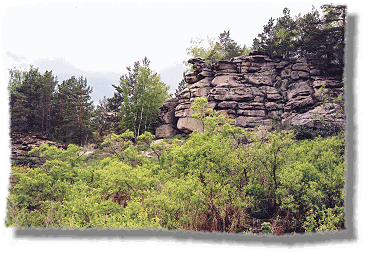 |
I had a late start and took a leisurely walk to the venue. I got a great spectator view of the route choices of the first runners on the first leg. This was probably unfair -- I don't think the organizers considered people walking from the summer houses. Watched Sharon start with some F21 type -- don't think orienteering matters -- she outran the F21 for the first 300 meters simply by being able to read while running, while the other woman, who was clearly in shape and much faster, had to keep stopping to check map and terrain.
About 2 minutes before my start, it started to pour. I mean -- a deluge. You could see the storm coming in off the lake and into the terrain. This affected my route choice to the first leg, as I had planned to go straight (after watching everyone else), but the rain made the rough open look much less appealing and more physical looking. I observed that the map cases were not sealed, and that if I were not careful, my map would become a waterlogged mush.
I boomed the first control. I think I was distracted by the rain, and not mentally prepared once it started raining. I remember thinking it was bad luck that the other starters did not have to deal with it. I remember worrying about the map, and wondering how the organizers can be so not-with-it as to not seal the map cases. I boomed the second control. Someone who was following me asked me in Russian where the control was. I found it, and never saw them again. My Russian was not good enough to answer them. I was not in sync at all.
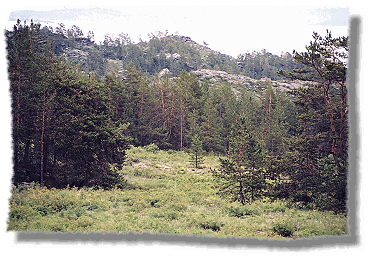 |
While these booms were unfortunate, they weren't huge disasters, and I was proud of myself for hanging in there and reeling off a string of good controls in a difficult area, after those first two. Then, I did lose contact attacking #13, and found it by luck, and also lost it on the way to #16, for about 4 minutes. Not a good race by any means, but not a disaster either.
At one point, I encountered these people just waiting for me, to ask were we were. I hate this and declined. Later, someone was waiting at a control, and as I left, they followed me. I attacked my next control, and it wasn't theirs. Good!
9.37 min/k, middle of the pack, 637 WRE points. Worse race that I actually finished.
 |
I was caught by a Swede at #4 (Tobias, I think), and we raced a bit 'til #8. He boomed #8 way right, and I knew it, but I did not have confidence in myself -- I said this guy is better than me, and I talked myself into
 |
These three days really did turn out to be some fantastic orienteering, on interesting terrain, excellent maps, and fine course setting (tho perhaps a few too many controls in cases).
 |
Our time in the Altay foothills was over. There was another model event close to town, on a steep, craggy open area. I generally take model events at race pace, but in this case I assumed it would not be relevant, and I actually wanted to rest. I figured I'd walk most of it, and only run in the challenging areas.
But I could not keep contact with anything. I decided I was just going to look for "that boulder", and could not find it. I could not believe how hard it was. I said, if the next races are as hard as this model, it is going to be a long day.
But everyone had the same opinion -- that the map was a joke -- and not to feel bad about not being able to keep contact. Apparently the model map was older, and not made by the same mappers.
[Full map and routes here]
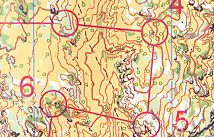 |
Alot of open area with many pockets of technical areas and forest. The forest was pine, the green seemed to be overmapped (i.e., it was faster than med green), but the mapping was still up to the excellent standards.
I let it fly and ran 6.67 min/k, not too bad. But I was outrunning my navigation, I realised in retrospect, counting on the fact that the penalties were low, tho I did not realise this at the time. I ended up booming 7 controls, but don't think I lost more than 2 or 3 minutes total as a result. So I never thought too much about it, which was a mistake. One thing that had been happening on this trip was that I was really strong in the circle, but this wasn't true of this race. But all this thought was in retrospect.
Even tho it wasn't my best run statistically, (705 WRE points; 13th place, 10 min behind the winner), it felt like the best. I was psyched and had a ton of confidence.
There was a protest on this race. It hinged on 2 controls being on the same feature, but being less than 50m apart (#8, and the distinct tree near #8). I always thought this was a USOF thing, but apparently not. The protester punched the wrong one. (In my case, I went to the wrong one, as it was on the facing side, checked the code, and then found the correct one, which was on the far side). The protester asked to be reinstated with a time penalty, rather than have the course voided. The protest was upheld, but the jury would not reinstate, nor throw out the leg, as there was no rule to do so, or reinstate with a time penalty. The jury honored the protester's request and did not void the course. This whole business was a bit of a shame, as this(these) were simply gimme spectator controls, and really had no bearing on the race.
[Full map and routes here]
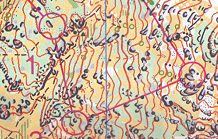 |
My pre-race planning was to plan for fast, open terrain like the day before. Just let it fly. But it did not work out that way.
I boomed the first control. It was one of those cases where I was going into punch, and there was no bag. I did not know what happened, where I was, and could not relocate. I know I was to the left as I eventually relocated off the small hill 120m to the ENE. I think what happened is that the course setter set up a parallel error trap with the parallel corridors of yellow, and I went in the wrong one, to the left of the line. Alot of features lined up, and bending the map did the rest.
I boomed the second control. Again, going in I thought I was in good shape, but no bag. There was speculation that this was mishung. In any case, I was already in the tank for 9 minutes of errors on the first two controls.
I kept plugging and spiked #3. I thought I was in good shape going into #4, but never saw the big cliffs. Another 4 minutes lost. #5 and #6 where gimmes, and #7 didn't look too bad, so long as I was careful to attack off those rock clusters and pick up the green, but I got over the ridge and nothing made sense. I could not relocate and wandered into the control by blind luck. 7 more minutes lost. I just simply could not understand why I could not navigate, and I was 20 minutes in the hole at this point.
#8 thru #10 went ok, but on #11, I got on the rocky outcropping to the right, losing another 4 minutes. There seemed to be alot more rock there than mapped, and it looked right, so I treasure hunted in there a bit. Lost contact in route to #12, and found myself on the trail to the left, and definitely found some unmapped rocks on the way in.
#13-#15 went ok, and I was still pushing it, but just fell apart on #16. Again, thought I was in good shape, but the veg did not make sense as I went in. To make matters worse, I was being followed, and my follower was no help. Got some great relocation training, as this is a difficult area to relocate in, but I still think I lost 10 minutes or so.
Spiked #17 but lost 6 minutes on #18 by going down the wrong series of cliffs. Think I'm about 38 minutes in the hole by now. Simply walking to #19, I lost contact as I went in. This was a tough leg and the green was physical, but you ought to be able to maintain contact at a walk.
At that point I decided to retire. I'm not sure why. Resigning just seemed like the right thing to do.
I don't recall ever having a race like this. My bad races are generally spiking most controls, and have blowouts on one or two. I wonder what happened? I think it was alot of factors. I think it was Kooyoora difficulty, but I was still on Laramie difficulty, and never adjusted. At Kooyoora, I had the same sort of difficulties on the first 4 controls, but adjusted and had a respectable run after that. I did not adjust here.
There was alot of parallel error going on, I think. I think that is what happened on #7, but I never confirmed it. I'm weak on parallel error.
I remember being really hungry. I rarely feel hungry during a race. I otherwise felt fine physically; I don't know if that was a factor or not.
The terrain was very high penalty, unlike the day before. I may have orienteered just as well, but where I was getting stung for 10 seconds yesterday, was getting stung for 4 minutes today. That doesn't seem possible, but I suppose it is. I think yesterday buttered me up. I did not recognize that the terrain was high penalty. All those big rocks, how could you get lost for long?
Perhaps I was cocky, but I don't think so. I never really get cocky. In any case, this disaster will remain a mystery, I suppose. It is a shame to have such a bad race on such a sweet area, but at least I got to enjoy the spectacular wildflowers, such as Siberian iris and many more I could not identify.
I guess the bottom line is that it is clear that I am not that good, but am often intensly lucky.
 |
There really wasn't much to do around here on the off day. The program listed "National Tarts" and another model event, and I spent some time trying to figure out what the former meant. I think it was a misprint of "National Starts", which is a rough translation of some sort of horse racing, but both this and the model were canceled, so it didn't matter. I spent the morning wandering thru the bazaar and on the Internet, reading AttackPoint and Spike's blog. One thing that was nice about the bazaar was that people weren't in your face trying to sell you stuff, like in other parts of the world. The beef kabobs for sale there were quite tasty, tho I was admonished (I think jokingly) by my interpreters for taking that as lunch.
I hung with my group which included Adrian and Charlotte from Canada, and some people from Western Europe who had booked thru Scottish O Tours. They had broken us into groups for the purpose of assigning the interpreters, and they put me in this group. This was a cool group, and we talked about, well, orienteering most of the time while draining 80 cent pivo at the hotel cafe.
There was this one dude from Norway who was my kind of O geek. He had orienteered in 65 countries and had one after the other O stories to tell. As an example, we were talking about route choice, and he brought this story out --
Hanne is leading Simone and one other runner late in a mass start race in Norway. The route choice is a trail run around and thru the forest. Hanne figures the trail run is faster, but that if she chooses that, Simone will outrun her. She figures she could outrun Simone on the slower route thru the forest, and that the latter will follow out of respect. That is what she did, what happened, and Hanne won the race.
I'm not sure when this was, but it was just one after the other of cool stories like this. It made you think about orienteering, which is always a good thing, and forget about that disastrous race yesterday.
For dinner, we found a traditional Kazakh restaurant, with a cool rotating table. We were introduced to the national dish (horse meat), as well as other delicacies (mostly dumpling like things of lamb). It was quite tasty, but everything, here and elsewhere on the trip, was really fatty. I felt I was on the Atkin's diet, but unfortunately I gained weight rather than lost it.
[Full map and routes here]
 |
The relay venue and course setting were certainly the weakest link of the series of races, IMO. Again, it seemed a case where the organizers went out of their way to set something for spectators at the expense of interesting orienteering for the competitors. The one small area of the course that actually required some navigation skills was questionably mapped, and the rest was simply hill climbs and run as fast as you can thru open terrain (tho I anticipate writing a separate olog article on the route choice from 9 to 10). One thing that was nice was the printing of the control code on the map. They need to start doing this for relays in the US.
I ran first leg and had a decent run, somewhere under 7 min/k in the hilly terrain. I was one of 3 first leg runners under 30 minutes, and one of six overall (I doubt we'll ever see results from the organizers). I gave us a one minute lead over the Canadians, and about 2 minutes over the Brits. We beat both of those, finishing 8th overall, 5th APOC eligible. We really had no realistic chance at a medal, tho everyone gave it their all. My orienteering, tho, was far from clean, but the time lost minor. I did not cost us a place. In this case, tho, there was some game theory -- the only chance at a medal was to run as absolutely fast as possible, and hope for the best. It would not have mattered. We did not see other teams come in, so we thought we were in third, so it was fun to cheer.
 |
It was definitely a fun and worthwhile trip, and I am glad I went. This was probably my best series of international events (running 21E, anyway), and I was for the most part happy with my races, thought the mapping was outstanding, and thought most of the venues were outstanding. The organization was not what we are used to in the West, but once you got used to not being in control, not worrying that the bus drivers had no clue how to get to the venues, were lucky to not be on the busses that broke down (2 did), that start lists and results could be hard to find, but that in the end everything worked out if you went with the flow, it was fine. The girls and the organizers were very nice, friendly, and helpful (even if wrong alot of the time), and that counts for a lot with me. I would suggest to the organizers that they next try organizing a World Rogaining Championship -- it would be less events and logistical cost at each one to deal with, and those hills in the Altay foothills would be a fabulous venue for such. And I could enjoy those wildflowers again.
Sharon Crawford cleaned up in terms of hardware. I believe she won every race in her class. Other North Americans on the podium where Adrian Zissos (CAN, M45, APOC middle), and Alex Kerr (CAN, M65, Open Cup of Kazakhstan).
As for my part, 3 of my races were my best 3 WRE scores ever, and the 4th was my 5th or 6th best. As a result, I got my ranking up to 314 in the world, and got that little "R" next to my name, which has been one of my sort of unimportant ultimate goals. Either my interval training paid off, the terrain suited me, or the bizarre mathematics of the rankings calculations broke favorably in these races for reasons I'll never know. I imagine it is a bit of all of these, tho probably more of the latter. I imagine that when they are normalized at the end of the year, they will come down alot, but for this one time couch potato and always geek, I can enjoy what looks like improvement it until that happens. Of course, no race was clean, and there was the disaster, so there continues to be opportunity for better results via technical improvement. I wonder how many years it takes to get good -- my guess is its different for everyone, but certainly more than 6 for me.
Occasionally I wonder if I would have made it to the podium had I run my age. I don't like to do this, but since this is the biggest championship I can enter, it seems appropriate to at least think about it. Based on min/k, I think I would have been clocking in at about 4th or 5th, so on any given day, perhaps I had a chance with some good luck. It is really hard to say tho, as the courses are always different. The field was stacked with some good Russian and Kazakh runners (at least based on time per k). Of course, I wasn't going to fly halfway around the world and not run the longest course possible -- I thought the M21E classic courses were too short, and many age class runners were heard to complain that their WTs were too low.